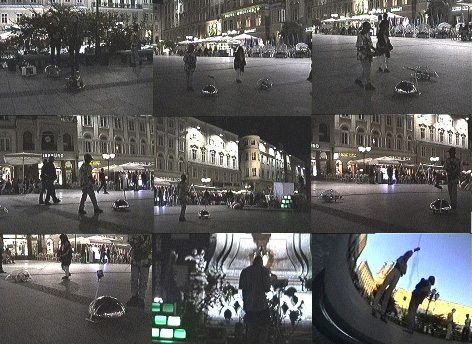

We are intimate terms with our terrestrial habitat by now, but perhaps only on the most superficial level.
Step by step we have mapped our world empirically by instrument and by the movement of our physical selves across, above and below it.
We now live in a world where technology enables each individual's exact location to be transparent. Where we are is suddenly every body's business.
The world is now indeed a stage, an amphitheater, a world of worlds, a theater in the round, a pluralistic armature lending itself simultaneously to both the portrayal and enactment of theatrical events.
It would seem then that our only chance to enjoy the adventure of anonymity and solitude is to keep on the move, to keep on traveling to quickly to be registered on instruments of our own making. The shortest distance between two points may now be a str aight line traveled at a very accelerated speed. A return to the nomadic life may be the only opportunity we may have to be heard and not seen.
As many other natural creatures in the world, we move in the world in tight clusters and carry on our activities in an organized urban frenzy. Each of us has our own particular agenda and, as the robots do, play our role as archivist, librarian, detec tive spy and/or archaeologist.
In Globe Theater, a panoply of robots appear and disappear , moving along the map writing down the world, creating a diagrammatic scripting, coding, mapping, of their own. Scurrying along, they carry nostalgia in front of them like a banner, conjuring up not only territory itself as it was, is and shall be, but the anticipation of new territory, the mysterious part of the road about to be underfoot but yet unknown.
By the gatherings of information and imagery and interpretations of their findings, the locale in which these robotic actors spring up becomes a series of stage-sets They keep on the move as a form of projection, traveling in clusters through the phy sical world exhibiting some of our best qualifies: curiosity, the ability to wonder, and a passion for study, interpretation and display of human history. Like a false door of an Ancient Egyptian tomb, the frenzy of these idiosyncratic characters and their dramatic adventures masks and protects a subtext: a political devotion to keeping imagination alive.
These intrepid characters explore and remap the world ideologically again, retaining all its diversity, and even deepening it. They are not limited to either a medieval flat, circular disc or a round sphere. To these curiosity machines, the world is chameleon-like, and can change shape, color and scope at will.
The stories emerging from the efforts of these robotic creatures, are expressed in their own form of theatrical play, emulating medieval pageantry and the genres of detective and mystery stories, science fiction, fables, scholarly and scientific reportin g and journalism. As artists, we are now inventors, archaeologists, and detectives. Like the robots, our studies tend to bridge things ,to discard arbitrary borders between isolated and juxtaposed things. Robots and computers liberate us from the pros pect of being overwhelmed by all the information in the world. It is their turn now to handle the storage, organization and access to information, leaving us, hopefully, free for the breaking of new artistic and philosophical ground.
Robots scurry around appearing, disappearing and reappearing in the city. They take in video and display it back to monitors , and/or record it for future memories. Images are collected and displayed on the walls and floors of the city
-© Adrianne Wortzel 1997